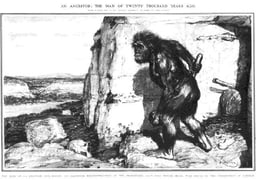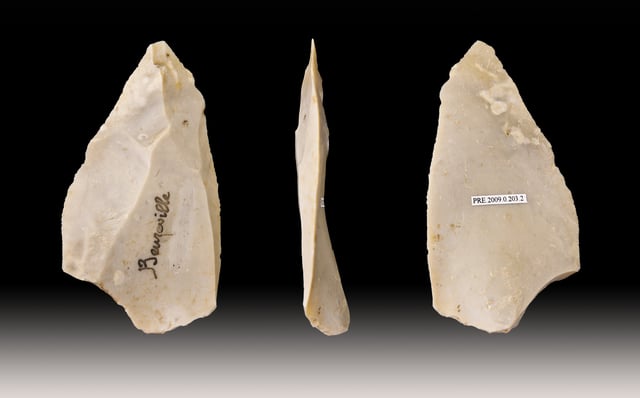Neanderthal
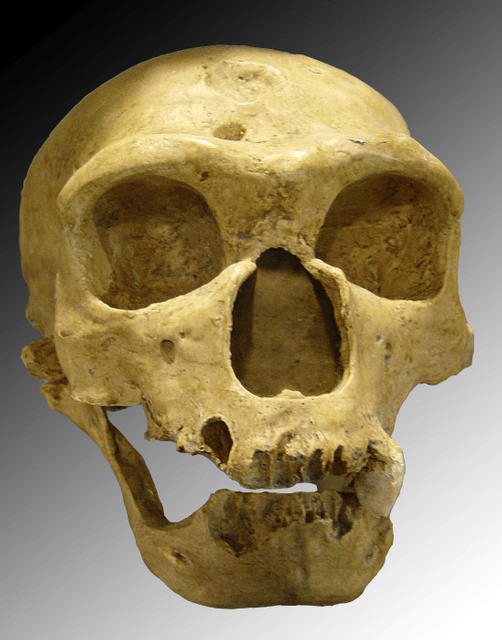
Neanderthal

| Neanderthal | |
|---|---|
| |
 | |
| An approximate reconstruction of a Neanderthal skeleton. The central rib cage, including the sternum, and parts of the pelvis are from modern humans. | |
| Scientific classification | |
| Kingdom: | Animalia |
| Phylum: | Chordata |
| Class: | Mammalia |
| Order: | Primates |
| Suborder: | Haplorhini |
| Infraorder: | Simiiformes |
| Family: | Hominidae |
| Subfamily: | Homininae |
| Tribe: | Hominini |
| Genus: | Homo |
| Species: | †H. neanderthalensis |
| Binomial name | |
| Homo neanderthalensis King, 1864 | |
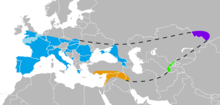 | |
| Known Neanderthal range in Europe (blue), Southwest Asia (orange), Uzbekistan (green), and the Altai Mountains (violet). | |
| Synonyms | |
Neanderthals (/niˈændərtɑːl, neɪ-, -θɔːl/;[8] German: [neˈ(ʔ)andɐtaːl];[9][10] Homo neanderthalensis or Homo sapiens neanderthalensis)[11] are an extinct species or subspecies of archaic humans in the genus Homo, who lived within Eurasia from circa 400,000 until 40,000 years ago.[12] [13][14][15][16]
Currently the earliest fossils of Neanderthals in Europe are dated between 450,000 and 430,000 years ago, and thereafter Neanderthals expanded into Southwest and Central Asia. They are known from numerous fossils, as well as stone tool assemblages. Almost all assemblages younger than 160,000 years are of the so-called Mousterian techno-complex, which is characterised by tools made out of stone flakes.[17] The type specimen is Neanderthal 1, found in Neander Valley in the German Rhineland, in 1856.
Compared to modern humans, Neanderthals were stockier, with shorter legs and bigger bodies. In conformance with Bergmann's rule, as well as Allen's rule, this was likely an adaptation to preserve heat in cold climates. Male and female Neanderthals had cranial capacities averaging 1,600 cm3 (98 cu in) and 1,300 cm3 (79 cu in), respectively,[18][19][20] within the range of the values for anatomically modern humans.[21] Average males stood around 164 to 168 cm (65 to 66 in) and females 152 to 156 cm (60 to 61 in) tall.[22]
There has been growing evidence for admixture between Neanderthals and anatomically modern humans, reflected in the genomes of all modern non-African populations but not in the genomes of most sub-Saharan Africans.[23][24][25] The proportion of Neanderthal-derived ancestry is estimated to be around 1–4% of the modern Eurasian genome.[23] This suggests that some interbreeding between Neanderthals and anatomically modern humans took place after the recent "out of Africa" migration of around 50-70,000 years ago.[26][27][28] Recent admixture analyses have added to the complexity, finding that Eastern Neanderthals derived up to 2% of their ancestry from an earlier wave of anatomically modern humans who left Africa some 100,000 years ago.[29]
| Neanderthal | |
|---|---|
| |
 | |
| An approximate reconstruction of a Neanderthal skeleton. The central rib cage, including the sternum, and parts of the pelvis are from modern humans. | |
| Scientific classification | |
| Kingdom: | Animalia |
| Phylum: | Chordata |
| Class: | Mammalia |
| Order: | Primates |
| Suborder: | Haplorhini |
| Infraorder: | Simiiformes |
| Family: | Hominidae |
| Subfamily: | Homininae |
| Tribe: | Hominini |
| Genus: | Homo |
| Species: | †H. neanderthalensis |
| Binomial name | |
| Homo neanderthalensis King, 1864 | |
 | |
| Known Neanderthal range in Europe (blue), Southwest Asia (orange), Uzbekistan (green), and the Altai Mountains (violet). | |
| Synonyms | |
Name and classification

Reconstitution of Le Moustier Homo neanderthalensis by Charles R. Knight
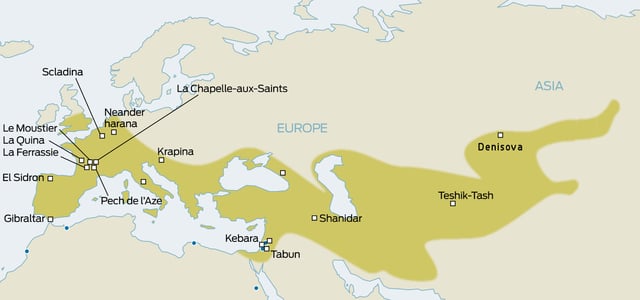
Distribution of the Neanderthal, and main sites.
Neanderthals are named after one of the first sites where their fossils were discovered in the mid-19th century in the Neander Valley, just east of Düsseldorf, at the time in the Rhine Province of the Kingdom of Prussia (now in North Rhine-Westphalia, Germany). The valley itself was named for Joachim Neander, Neander being the Hellenized form of the surname Neumann ("new man").[30][31][32] The German spelling of Thal (valley) was current in the 19th century; it is now spelled Tal.[1][5]
Neanderthal 1 was known as the "Neanderthal cranium" or "Neanderthal skull" in anthropological literature, and the individual reconstructed on the basis of the skull was occasionally called "the Neanderthal man".[33] The binomial name Homo neanderthalensis—extending the name "Neanderthal man" from the individual type specimen to the entire group—was first proposed by the Anglo-Irish geologist William King in a paper read to the British Association in 1863,[34][35] although in the following year he stated that the specimen was not human and rejected the name.[36] King's name had priority over the proposal put forward in 1866 by Ernst Haeckel, Homo stupidus.[5] Popular English usage of "Neanderthal" as shorthand for "Neanderthal man", as in "the Neanderthals" or "a Neanderthal", emerged in the popular literature of the 1920s.[37]
Since the historical spelling -th- in German represents the phoneme /t/, not the fricative /θ/, standard British pronunciation of "Neanderthal" is with /t/ (IPA: /niːˈændərtɑːl/).[38][39][40][41][42][43][44] Because of the usual sound represented by the digraph ⟨th⟩ in English, "Neanderthal" is also pronounced with the voiceless fricative /θ/ (as /niːˈændərθɔːl/).[45]
The spelling Neandertal is occasionally seen in English, even in scientific publications. Since "Neanderthal", or "Neandertal", is a common name, there is no authoritative prescription on its spelling, unlike the spelling of the binominal name H. neanderthalensis, which is predicated by King 1864.[46] The common name in German is invariably Neandertaler (lit. "of the valley of Neander"), not Neandertal, but the spelling of the name of the Neander Valley itself (Neandertal vs. Neanderthal) has been affected by the species name, the names of the Neanderthal Museum and of Neanderthal station persisting with pre-1900 orthography.[47]
Ever since the discovery of the Neanderthal fossils, expert opinion has been divided as to whether Neanderthals should be considered a separate species (Homo neanderthalensis) or a subspecies (Homo sapiens neanderthalensis) relative to modern humans.[48][49][50][51] Svante Pääbo (2014) described such "taxonomic wars" as unresolveable in principle, "since there is no definition of species perfectly describing the case."[11] The question depends on the definition of Homo sapiens as a chronospecies, which has also been in flux throughout the 20th century. Authorities preferring classification of Neanderthals as subspecies have introduced the subspecies name Homo sapiens sapiens for the anatomically modern Cro-Magnon population which lived in Europe at the same time as Neanderthals, while authorities preferring classification as separate species use Homo sapiens as equivalent to "anatomically modern humans".
During the early 20th century, a prevailing view of Neanderthals as "simian", influenced by Arthur Keith and Marcellin Boule,[52] tended to exaggerate the anatomical differences between Neanderthals and Cro-Magnons. Beginning in the 1930s, revised reconstructions of Neanderthals increasingly emphasized the similarity rather than differences from modern humans. From the 1940s throughout the 1970s, it was increasingly common to use the subspecies classification of Homo sapiens neanderthalensis vs. Homo sapiens sapiens.[53] The hypothesis of "multiregional origin" of modern man was formulated in the 1980s on such grounds, arguing for the presence of an unbroken succession of fossil sites in both Europe and Asia.[54] Hybridization between Neanderthals and Cro Magnon had been suggested on skeletal and craniological grounds since the early 20th century, and found increasing support in the later 20th century,[55] until Neanderthal admixture was found to be present in modern populations' genomes in the 2010s.
Evolution
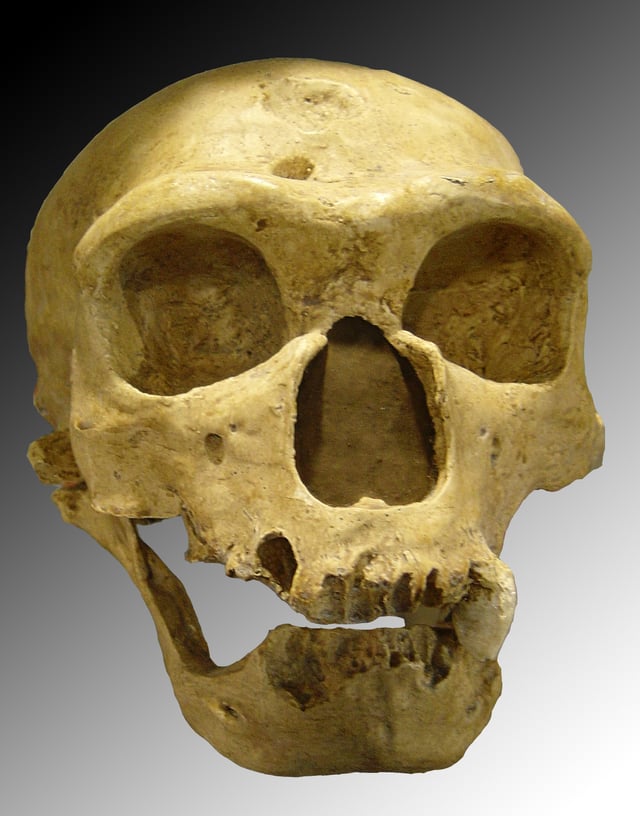
Stage 4: Classic European Neanderthal (La Chapelle-aux-Saints 1, 50 ka)
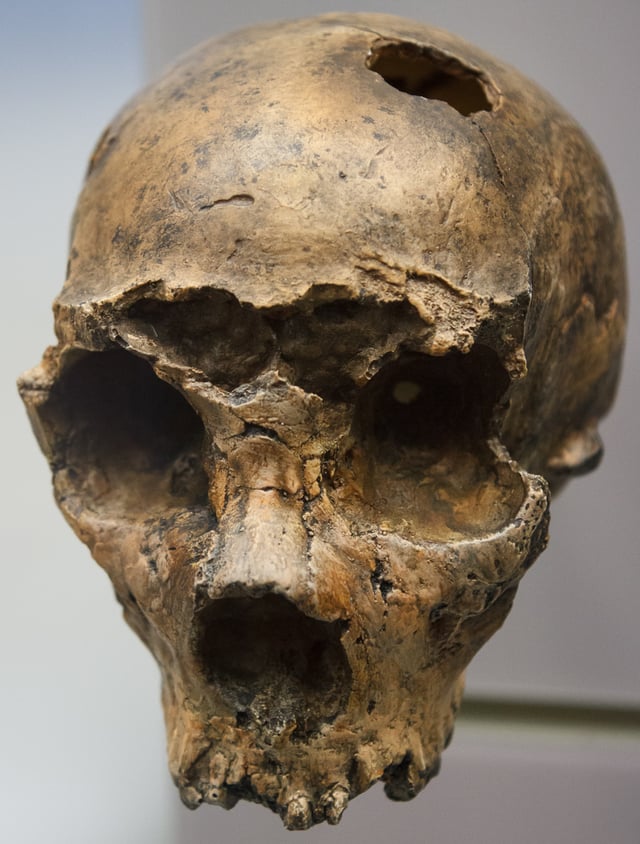
Stage 3: Intermediate Neanderthal (Saccopastore I, 130 ka)

Stage 2: Archaic Neanderthal (Miguelón, 430 ka)
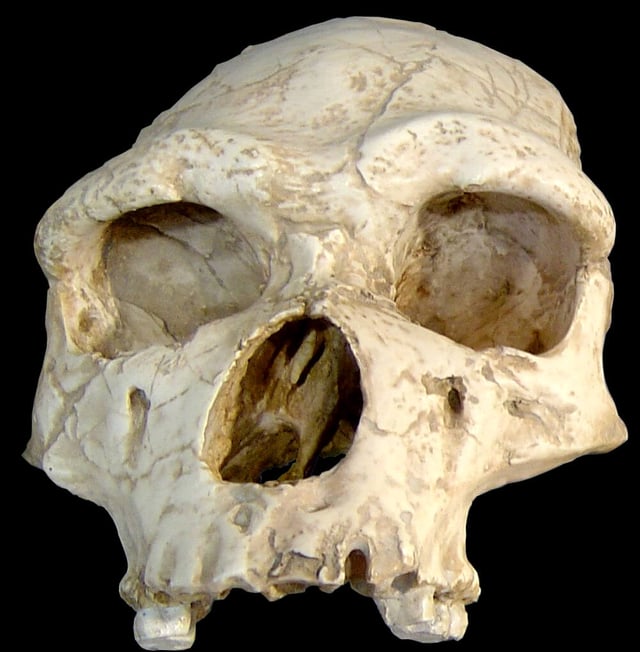
Stage 1: Early pre-Neanderthal, possibly Homo erectus, (Tautavel Man, 450 ka)
Both Neanderthals and anatomically modern humans were initially thought to have evolved from Homo erectus between 300,000 and 200,000 years ago. H. erectus had emerged around 1.8 million years ago, and had long been present, in various subspecies throughout Eurasia.
The time of divergence between archaic Homo sapiens and ancestors of Neanderthals and Denisovans caused by a population bottleneck of the latter was dated at 744,000 years ago, combined with repeated early admixture events and Denisovans diverging from Neanderthals 300 generations after their split from Homo sapiens, was calculated by Rogers et al. (2017).[58][59]
Homo heidelbergensis, dated 600,000 to 300,000 years ago, has long been thought to be a likely candidate for the last common ancestor of the Neanderthal and modern human lineages. However, genetic evidence from the Sima de los Huesos fossils published in 2016 seems to suggest that H. heidelbergensis in its entirety should be included in the Neanderthal lineage, as "pre-Neanderthal" or "early Neanderthal", while the divergence time between the Neanderthal and modern lineages has been pushed back to before the emergence of H. heidelbergensis, to about 600,000 to 800,000 years ago, the approximate age of Homo antecessor.[60]
The taxonomic distinction between H. heidelbergensis and Neanderthals is mostly due to a fossil gap in Europe between 300,000 and 243,000 years ago (MIS 8). "Neanderthals", by conventions, are fossils which date to after this gap.[61][62] The quality of the fossil record greatly increases from 130,000 years ago onwards.[63] Specimens younger than this date make up the bulk of known Neanderthal skeletons and were the first whose anatomy was comprehensively studied.[64][65] In morphological studies, the term "classic Neanderthal" may be used in a narrower sense for Neanderthals younger than 71,000 years old (MIS 4 and 3).[61]
Microbiome
Neanderthals lived alongside modern humans until their extinction between 40,000–30,000 years ago,[66] and share a common ancestor which could tell us more about how our microbiome evolved.[67] Using dental calculus, calcified bone that traps microorganisms, researchers can understand how ancient human microbiomes may have evolved.[68] Based on a 16s shotgun sequence of dental calculus found in neanderthal specimens, researchers have found a large portion of neanderthal oral microbiome contained Actinobacteria, Firmicutes, Bacteroidetes, Proteobacteria, much like modern humans, but also Euryarchaeota, fungi, and some oral pathogens that modern humans lack.[67]
The diet of neanderthals depended on the environment they lived in. Neanderthal remains recovered from Spy Cave, Belgium and examined using dental calculus, indicate neanderthals in this area had a meat-based diet, including woolly rhinoceros and wild sheep.[67] In comparison, remains found in El Sidrón Cave, Spain, indicate the presence of a large amount of plant material such as nuts and moss, as well as mushrooms in the diet.[67] Researchers determined that the difference in diets contributed to the neanderthal microbiota, and meat-based diet caused the most variation.[67] According to fecal biomarkers, neanderthals were able to convert cholesterol to coprostanol at a high rate, much like modern humans, because of the bacteria present in their gut.[69]
Habitat and range
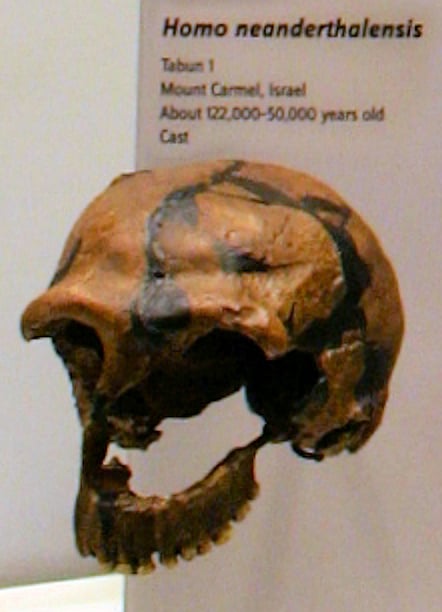
The southernmost Neanderthal: Homo neandertalensis fossil from Tabun Cave, Israel. 120.000–50.000 BC. Israel Museum.
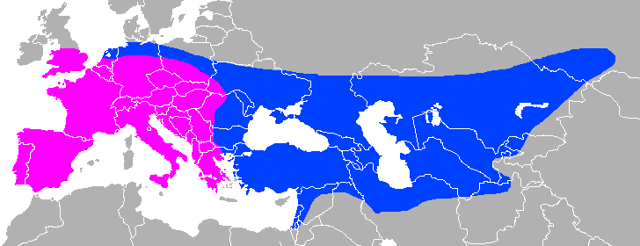
Approximate Neanderthal range; pre-Neanderthal and early Neanderthal range shown in purple, late Neanderthal range in blue.

Sites where "classic Neanderthal" fossils (70–40 kya) have been found. Ice sheets during the Last Glacial Maximum (approx. 25-15 kya) are indicated. These are significantly larger than at 70-40 kya.
Early Neanderthals, living before the Eemian interglacial (130 ka), are poorly known and come mostly from European sites. From 130 ka onwards, the quality of the fossil record increases dramatically. From then on, Neanderthal remains are found in Western, Central, Eastern, and Mediterranean Europe,[70] as well as Southwest, Central, and Northern Asia up to the Altai Mountains in Siberia. No Neanderthal has ever been found outside Central to Western Eurasia, namely neither to the south of 30°N (Shuqba, Levant), nor east of 85°E (Denisova, Siberia).
The limit of their northern range appears to have been south of 53°N (Bontnewydd, Wales),[71] although it is difficult to assess because glacial advances destroy most human remains, the Bontnewydd tooth being exceptional. Middle Palaeolithic artefacts have been found up to 60°N on the Russian plains.[72]
Total Neanderthal effective population size has been estimated at close to 15,000 individuals (corresponding to a total population of roughly 150,000 individuals), living in small, isolated, inbred groups.[73]
Analysis of the genomic DNA from three locations suggests that about 120,000 years ago there were genetically distinct Neanderthal populations in Western Europe and Siberia. Later specimens show that the western population not only still populated Europe through 40,000 years ago, but also had spread east, being present at the Siberian locale by 90,000 years ago.[74]
Anatomy

Anatomical comparison of skulls of Homo sapiens (Oase 1, left) and Homo neanderthalensis (right)(Cleveland Museum of Natural History).Features compared are the braincase shape, forehead, browridge, nasal bone projection, cheek bone angulation, chin and occipital contour.

Comparison of faces of early European Homo sapiens (left) and Homo neanderthalensis (right) based on forensic facial reconstructions exhibited at the Neanderthal Museum.
Neanderthal anatomy differed from modern humans in that they had a more robust build and distinctive morphological features, especially on the cranium, which gradually accumulated more derived aspects as it was described by Marcellin Boule,[75] particularly in certain isolated geographic regions. These include shorter limb proportions, a wider, barrel-shaped rib cage, a reduced chin, sloping forehead, and a large nose, being at the modern human higher end in both width and length,[2] and started somewhat higher on the face than in modern humans. The Neanderthal skull is typically more elongated and less globular than that of anatomically modern humans, and features a notable occipital bun.[62] Inherited Neanderthal DNA variants may subtly influence the skull shape of living people.[76]
Neanderthals were much stronger than modern humans, with particularly strong arms and hands, while they were comparable in height; based on 45 long bones from 14 males and 7 females, three different methods of estimating height produced averages for Neanderthal males from 164 to 168 cm (65 to 66 in) and 152 to 156 cm (60 to 61 in) for females.[22] Samples of 26 specimens found an average weight of 77.6 kg (171 lb) for males and 66.4 kg (146 lb) for females.[77]
Neanderthals are known for their large cranial capacity, which at 1,600 cm3 (98 cu in) is larger on average than that of modern humans. One study has found that drainage of the dural venous sinuses (low pressure blood vessels that run between the meninges and skull leading down through the skull) in the occipital lobe region of Neanderthal brains appears more asymmetric than other hominid brains.[78] Three-dimensional computer-assisted reconstructions of Neanderthal infants based on fossils from Russia and Syria indicated that Neanderthal and modern human brains were the same size at birth, but that by adulthood, the Neanderthal brain was larger than the modern human brain.[79] They had almost the same degree of encephalisation (i.e. brain-to-body-size ratio) as modern humans.[80][81]
Three-dimensional reconstructions of nasal cavities and computational fluid dynamics techniques have found that Neanderthals and modern humans both adapted their noses (independently and in a convergent way) to help breathe in cold and dry conditions.[82] The large nose seen in Neanderthals, as well as Homo heidelbergensis, affected the shape of the skull and the muscle attachments, and gave them a weaker bite force than in modern humans.[83] Larger eye sockets and larger areas of the brain devoted to vision suggest that their eyesight may have been better than that of modern humans.[84] Dental remains from two Italian sites indicate that Neanderthal dental features had evolved by around 450,000 years ago during the Middle Pleistocene epoch.[85]
Two Neanderthal specimens from Italy and Spain were found to have an allele of the melanocortin 1 receptor (MC1R) with reduced activity. This receptor plays a role in mammalian pigmentation, and the activity of the novel allele in Neanderthals was found to be reduced sufficiently to allow for visibly lighter pigment expression.[86] Although not found in the small European sample studied by Lalueza et al., a larger study found that the derived variant was present at 70% frequency in Taiwanese Aborigines, 50% frequency in Cheyenne Native Americans, 30% frequency in Han Chinese, and 5% frequency in Europeans.[87] It is therefore unclear whether this loss-of-function variant is responsible for any other traits other than lightening the skin (such as red or blonde hair). This allele was not found in the Croatian or Altai Neanderthal specimens subjected to whole-genome sequencing, nor have the MC1R variants known to cause red hair in modern humans, though the Altai specimen was polymorphic for another variant MC1R allele of unknown effect.[88] Genomic analysis of three Croatian specimens for the alleles of numerous genes that affect pigment in modern humans showed the Neanderthals to have more of the alleles that produce dark pigment in modern humans than those producing reduced pigmentation. Based on this they concluded these Neanderthals had darker hair, skin and eye coloration than modern Europeans. Skin pigmentation prediction for archaic humans is controversial, as there are no living samples in which to evaluate the effect of SNP variants, and, with the tested samples coming from a single Neanderthal population, they may not be representative of the diversity across Neanderthals' full geographic range.[89]
The overall shorter limbs and in general more stout body proportions of Neanderthals may have been an adaptation to colder climates. In comparison to modern humans, Neanderthals were more suited for sprinting and pouncing activities rather than endurance running, which would have been adaptive in the forests and woodlands that seem to have been their preferred environment. Genomic evidence possibly points to a higher proportion of fast-twitch muscle fiber in the Neanderthal.[90] Evidence suggests that Neanderthals walked upright much like modern humans.[91][92]
Behaviour
Neanderthals made stone tools, used fire,[93] and were hunters. This is the extent of the consensus on their behaviour. It had long been debated whether Neanderthals were hunters or scavengers,[62] but the discovery of the pre-Neanderthal Schöningen wooden spears in Germany helped settle the debate in favour of hunting. A Levallois point embedded in the vertebrae of a wild ass indicated that a javelin had been thrown with a parabolic trajectory to disable the animal.[94] Most available evidence suggests they were apex predators,[95] and fed on red deer, reindeer, ibex, wild boar, aurochs and on occasion mammoth, straight-tusked elephant and rhinoceros.[62][96][97][98] They appear to have occasionally used vegetables as fall-back food,[99] revealed by isotope analysis of their teeth and study of their coprolites (fossilised faeces).[97] Dental analysis of specimens from Spy, Belgium and El Sidrón, Spain[100] suggested that these Neanderthals had a wide-ranging diet, with no evidence at all that the El Sidrón Neanderthals were carnivorous, instead living on "a mixture of forest moss, pine nuts and a mushroom known as split gill".[101] Nonetheless, isotope studies of Neanderthals from two French sites showed similar profiles to other carnivores, suggesting that these populations may have eaten meat.[102][103][104] The Neanderthal skeleton suggests they consumed 100 to 350 kcal (420 to 1,460 kJ) more per day than modern male humans of 68.5 kg (151 lb) and females of 59.2 kg (131 lb).[77]
The size and distribution of Neanderthal sites, along with genetic evidence, suggests Neanderthals lived in much smaller and more sparsely distributed groups than anatomically-modern Homo sapiens.[106][107] The bones of twelve Neanderthals were discovered at El Sidrón cave in northwestern Spain. They are thought to have been a group killed and butchered about 50,000 years ago. Analysis of the mtDNA showed that the three adult males belonged to the same maternal lineage, while the three adult females belonged to different ones. This suggests a social structure where males remained in the same social group and females "married out".[108]
The bones of the El Sidrón group show signs of defleshing, suggesting that they were victims of cannibalism.[108] The St. Césaire 1 skeleton from La Roche à Pierrot, France, showed a healed fracture on top of the skull apparently caused by a deep blade wound, suggesting interpersonal violence.[109] Shanidar 3, an adult male dated to the late middle Paleolithic, was found to have a rib lesion characteristic of projectile weapon injuries, which some anthropologists consider evidence for interspecies conflict.[110]
Neanderthals suffered a high rate of traumatic injury, with by some estimates 79% of specimens showing evidence of healed major trauma.[111] It was thus theorized that Neanderthals employed a riskier and possibly less sophisticated hunting strategy. However, rates of cranial trauma are not significantly different between Neanderthal and middle paleolithic Anatomically Modern Human samples.[112] Both populations evidently cared for the injured and had some degree of medical knowledge.
It was long believed that an adhesive (birch bark tar) made by Neanderthals required to follow a complex recipe, and that it thus showed complex cognitive skills and cultural transmission. A study from 2019 showed that birch tar production can instead be a very simple process - merely involving the burning of birch bark near smooth vertical surfaces in open air conditions.[113]
Claims that Neanderthals deliberately buried their dead, and if they did, whether such burials had any symbolic meaning,[63] [] are heavily contested.[114][115][116] The debate on deliberate Neanderthal burials has been active since the 1908 discovery of the well-preserved Chapelle-aux-Saints 1 skeleton in a small hole in a cave in southwestern France. In this controversy's most recent installment, a team of French researchers reinvestigated the Chapelle-aux-Saints cave and in January 2014 reasserted the century-old claim that the 1908 Neanderthal specimen had been deliberately buried,[117] and this has in turn been heavily criticised.[118]
According to archaeologist John F. Hoffecker:[119]
Neanderthal sites show no evidence of tools for making tailored clothing. There are only hide scrapers, which might have been used to make blankets or ponchos. This is in contrast to Upper Paleolithic (modern human) sites, which have an abundance of eyed bone needles and bone awls. Moreover, microwear analysis of Neanderthal hide scrapers shows that they were used only for the initial phases of hide preparation, and not for the more advanced phases of clothing production.— John F. Hoffecker, The Spread of Modern Humans in Europe
Culture
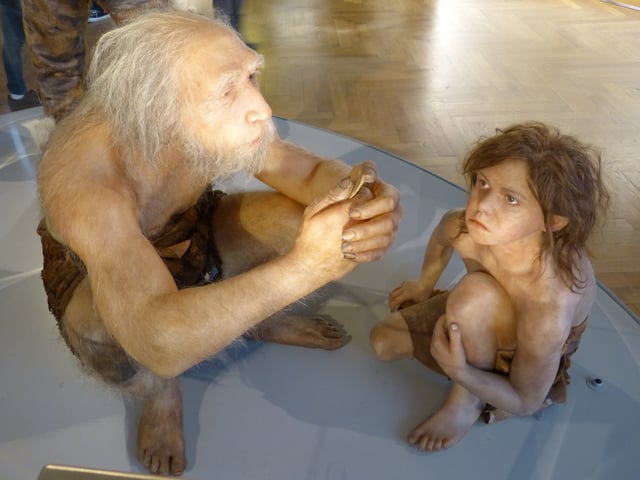
Artist's reconstruction of a Neanderthal man with child

Proposed Neanderthal jewelry: white-tailed eagle claw with striations at the Neanderthal site of Krapina, Croatia, circa 130,000 BP.[123]
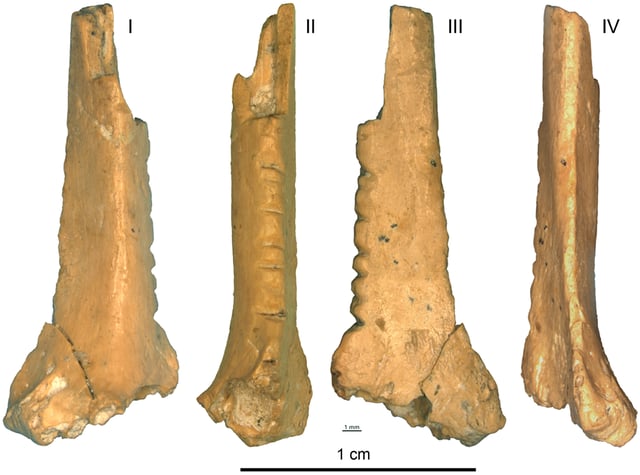
Proposed symbolic endeavour: incision-decorated raven bone from the Zaskalnaya VI (Kolosovskaya) Neanderthal site, Crimea, Micoquian industry dated to between cal. 43,000 and 38,000 BP.[133]
Whether Neanderthals created art and used adornments, which would indicate a capability for complex symbolic thought, remains unresolved. A 2010 paper on radiocarbon dates cast doubt on the association of Châtelperronian beads with Neanderthals,[124] and Paul Mellars considered the evidence for symbolic behaviour to have been refuted.[125] This conclusion, however, is controversial, and others such as Jean-Jacques Hublin and colleagues have re-dated material associated with the Châtelperronian artifacts[126] and used proteomic evidence to restate the challenged association with Neanderthals.[127]
A large number of other claims of Neanderthal art, adornment, and structures have been made. These are often taken by the media as showing Neanderthals were capable of symbolic thought,[128][129] or were "mental equals" to anatomically modern humans.[130][131] As evidence of symbolism, none of them are widely accepted,[132] although the same is true for Middle Palaeolithic anatomically modern humans. Among many others:
Flower pollen on the body of pre-Neanderthal Shanidar 4, Iraq, had in 1975 been argued to be a flower burial.[134] Once popular, this theory is no longer accepted.[135][136]
Bird bones were argued to show evidence for feather plucking in a 2012 study examining 1,699 ancient sites across Eurasia, which the authors controversially[137] took to mean Neanderthals wore bird feathers as personal adornments.[138]
Deep scratches were found in 2012 on a cave floor underlying Neanderthal layer in Gorham's Cave, Gibraltar, which some have controversially[139] interpreted as art.[140]
Two 176,000-year-old stalagmite ring structures, several metres wide, were reported in 2016 more than 300 metres from the entrance within Bruniquel Cave, France. The authors claim artificial lighting would have been required as this part of the cave is beyond the reach of daylight and that the structures had been made by early Neanderthals, the only humans in Europe at this time.[141]
In 2015, a study argued that a number of 130,000-year-old eagle talons found in a cache near Krapina, Croatia along with Neanderthal bones, had been modified to be used as jewelry.[142][143]
All of these appeared only in single locations. Yet in 2018, using uranium-thorium dating methods,[144] red painted symbols comprising a scalariform (ladder shape), a negative hand stencil, and red lines and dots on the cave walls of three Spanish caves 700 km (430 mi) apart were dated to at least 64,000 years old.[145] If the dating is correct, they were painted before the time anatomically modern humans are thought to have arrived in Europe. Paleoanthropologist John D. Hawks argues these findings demonstrate Neanderthals were capable of symbolic behaviour previously thought to be unique to modern humans.[146] Researchers also found perforated seashell beads and pigments that are at least 115,000 years old in Cueva de los Aviones, a cave in southeastern Spain.[147]
Interbreeding with archaic and modern humans

Chris Stringer's hypothesis of the family tree of genus Homo, published 2012 in Nature – the horizontal axis represents geographic location, and the vertical axis represents time in millions of years ago.[3]
An alternative proposal regarding the fate of Neanderthals is that rather than being replaced by modern humans and going extinct, Neanderthals were absorbed into the Cro-Magnon population by interbreeding. This would be counter to strict versions of theory of recent African origin of modern humans, since it would imply that at least part of the genome of Europeans would descend from Neanderthals. Evidence of interbreeding has been detected in genomes of ancient and modern humans, though this could have resulted from occasional interbreeding and introgression, rather than population absorption.
Pre-2010 interbreeding hypotheses
Until the early 1950s, most scholars thought Neanderthals were not in the ancestry of living humans.[149] [] [150] Nevertheless, in 1904 Thomas H. Huxley saw among Frisians the presence of what he suspected to be Neanderthaloid skeletal and cranial characteristics as an evolutionary development from Neanderthal rather than as a result of interbreeding, saying that "the blond long-heads may exhibit one of the lines of evolution of the men of the Neanderthaloid type," yet he raised the possibility that the Frisians alternatively "may be the result of the admixture of the blond long-heads with Neanderthal men," thus separating "blond" from "Neanderthaloid."[[151]](https://books.google.com/?id=7J1IAQAAMAAJ&pg=PA186&lpg=PA186&dq=Virchow+Beitr%C3%A4ge+zur+physischen+Anthropologie+der+Deutschen+(Abh.+der+K%C3%B6niglichen+Akademie+der+Wissenschaften+zu+Berlin,+1876#v=onepage&q=may%20exhibit%20one%20of%20the%20lines%20of&f=false)
Hans Peder Steensby proposed interbreeding in 1907 in the article Race studies in Denmark. He strongly emphasised that all living humans are of mixed origins.[152] He held that this would best fit observations, and challenged the widespread idea that Neanderthals were ape-like or inferior. Basing his argument primarily on cranial data, he noted that the Danes, like the Frisians and the Dutch, exhibit some Neanderthaloid characteristics, and felt it was reasonable to "assume something was inherited" and that Neanderthals "are among our ancestors."
Carleton Stevens Coon in 1962 found it likely, based upon evidence from cranial data and material culture, that Neanderthal and Upper Paleolithic peoples either interbred or that the newcomers reworked Neanderthal implements "into their own kind of tools."[153] Christopher Thomas Cairney in 1989 went further, laying out a rationale for hybridisation and adding a broader discussion of physical characteristics as well as commentary on interbreeding and its importance to adaptive European phenotypes. Cairney specifically discussed the "intermixture of racial elements" and "hybridisation."[55]
By the early 2000s, the majority of scholars supported the Out of Africa hypothesis,[154][155] according to which anatomically modern humans left Africa about 50,000 years ago and replaced Neanderthals with little or no interbreeding. Yet some scholars still argued for hybridisation with Neanderthals. The most vocal proponent of the hybridisation hypothesis was Erik Trinkaus of Washington University.[156] Trinkaus claimed various fossils as products of hybridised populations, including the skeleton of a child found at Lagar Velho in Portugal[157][158][159] and the Peștera Muierii skeletons from Romania.[160]
Genetic evidence
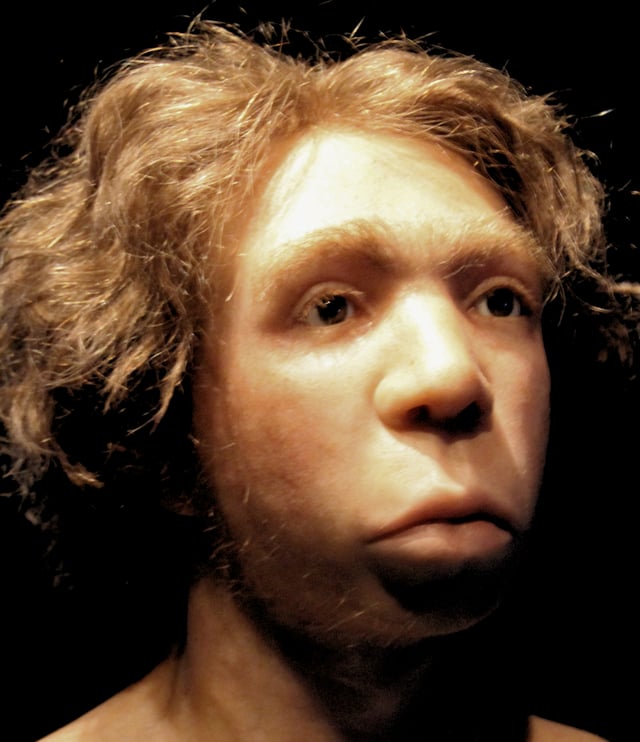
Le Moustier Neanderthal facial reconstitution, Neues Museum Berlin[161]

Neanderthal figure representation, Museum of Republika Srpska
In 2010, geneticists announced that interbreeding had likely taken place,[23][162] a result confirmed in 2012.[163][164][165] The genomes of all non-Africans (such as Europeans, Asians, and Oceanians such as Papua New Guineans)[23] include portions that are of Neanderthal origin,[166][167] a share estimated in 2014 to 1.5–2.1%.[168] This DNA is absent in Sub-Saharan Africans (Yoruba people and San subjects).[23] Ötzi the iceman, Europe's oldest preserved mummy, was found to possess an even higher percentage of Neanderthal ancestry.[169] The two percent of Neanderthal DNA in Europeans and Asians is not the same in all Europeans and Asians: in all, approximately 20% of the Neanderthal genome appears to survive in the modern human gene pool.[170]
Genomic studies suggest that modern humans mated with at least two groups of archaic humans: Neanderthals and Denisovans.[171] Some researchers suggest admixture of 3.4–7.9% in modern humans of non-African ancestry, rejecting the hypothesis of ancestral population structure.[172], and others later suggesting Neanderthal admixture of 1.5-2.1%.[168] Detractors have argued and continue to argue that the signal of Neanderthal interbreeding may be due to ancient African substructure, meaning that the similarity is only a remnant of a common ancestor of both Neanderthals and modern humans and not the result of interbreeding.[173][174] John D. Hawks has argued that the genetic similarity to Neanderthals may indeed be the result of both structure and interbreeding, as opposed to just one or the other.[175]
An approximately 40,000 year old anatomically-modern human skeleton from Peștera cu Oase, Romania, was found in 2015 to have a much larger proportion of DNA matching the Neanderthal genome than seen in humans of today, and this was estimated to have resulted from an interbreeding event as few as four generations earlier. However, this hybrid Romanian population does not appear to have made a substantial contribution to the genomes of later Europeans.[176][177]
While some modern human nuclear DNA has been linked to the extinct Neanderthals, no mitochondrial DNA of Neanderthal origin has been detected,[30] which in primates is almost always maternally transmitted.[178] This observation has prompted the hypothesis that whereas female humans interbreeding with male Neanderthals were able to generate fertile offspring, the progeny of female Neanderthals who mated with male humans were either rare, absent or sterile.[179]
Eastern Neanderthals from the Altai show evidence of an introgression from modern humans not seen in western Neanderthals.[29] This contribution to their genome derived from a modern human population that diverged from most other modern humans about 120 kya and expanded from Africa into Eurasia, but which was later largely replaced by a second expansion of modern humans out of Africa after 75,000 years ago that gave rise to modern Eurasians, although 2% of the genome of New Guineans derives from this earlier dispersal.[180] Kuhlwilm et al. argue that the admixture between this early modern human group, modern Eurasians, and Neanderthals took place in Southern Arabia or the Levant and that the introgressed Siberian Neanderthals had spread there from the Middle East.[29]
Interbreeding with Denisovans
Sequencing of the genome of a Denisovan, a distinct but related archaic hominin, from the Denisova cave in the Siberian Altai region has shown that 17% of its genome represents Neanderthal DNA.[181] This Neanderthal DNA present in the Denisovan genome more closely resembled that found in the genome of a 120,000-year-old Neanderthal bone found in the same cave than that of Neanderthals from the Vindija cave in Croatia or the Mezmaiskaya cave in the Caucasus, suggesting that the gene flow came from a local interbreeding.[168] However, the complete genome sequencing of DNA from a 90,000-year-old bone fragment, Denisova 11, showed it to have belonged to a Denisovan-Neanderthal hybrid whose father was a typical Denisovan with the Altai Neanderthal component dating to an interbreeding more than 300 generations earlier, but the specimen's mother was a Neanderthal belonging to a population more closely related to the Vindija Neanderthal than to the sequenced Altai Neanderthal genome. This suggests mobility or turnover among the distinct Neanderthal populations.[182][183][184][185]
mtDNA phylogeny
The mtDNA phylogeny of the Neanderthals, Denisovans, and modern humans produces a puzzling picture. Based on mtDNA sequences of Neanderthals from the Vindija and Altai sites, the most recent common ancestor of modern humans and Neanderthals lived approximately 440,000 years ago, while that between Neanderthals and Denisovans is far back as 830,000 years. This contrasts with nuclear genome analysis, in which the Neanderthals and Denisovans are sister groups.[186] The mtDNA of the 400,000-year-old Sima de los Huesos sample, thought to be ancestral to Western European Neanderthals, is much closer to Denisovan mtDNA.[186] Paabo et al. suggest several alternative explanations for this, including genetic substructure within the populations, introgression of mtDNA from one group to another, or incorrect taxonomic placement of the Sima de los Huesos hominins.[186] Peyrégne et al. again suggested genetic substructure or introgression as possible explanations for an approximately 124,000-year-old German Neanderthal specimen with mtDNA that diverged from that of other Neanderthal specimens (except for Sima de Huesos) about 270,000 years ago, while its genomic DNA was consistent with divergence less than 150,000 years ago.[74]
Extinction
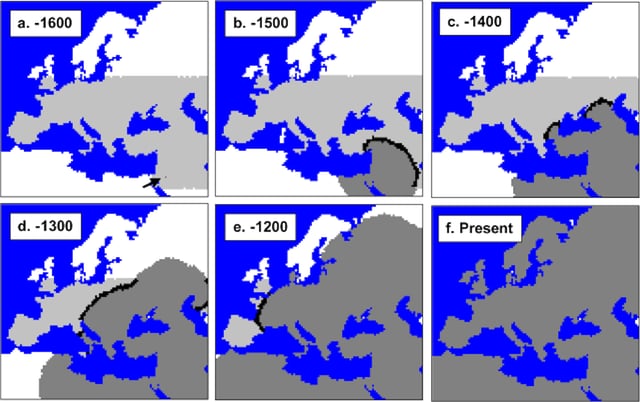
mtDNA-based simulation of modern human expansion in Europe starting 1,600 generations ago. Neanderthal range in light grey[187]
According to a 2014 study by Thomas Higham and colleagues of organic samples from European sites, Neanderthals died out in Europe between 41,000 and 39,000 years ago.[4] New dating in Iberia, where Neanderthal dates as late as 24,000 years had been reported before, now suggests evidence of Neanderthal survival in the peninsula after 42,000 years ago is almost non-existent.[15]
Anatomically modern humans arrived in Mediterranean Europe between 45,000 and 43,000 years ago, so the two different human populations shared Europe for several thousand years.[12][188] The exact nature of biological and cultural interaction between Neanderthals and other human groups is contested.[189]
Possible scenarios for the extinction of the Neanderthals are:
Neanderthals were a separate species from modern humans, and became extinct (because of climate change or interaction with modern humans) and were replaced by modern humans moving into their habitat between 45,000 and 40,000 years ago.[190] Jared Diamond has suggested a scenario of violent conflict and displacement.[191]
Neanderthals were a contemporary subspecies that bred with modern humans and disappeared through absorption (interbreeding theory).
Volcanic catastrophe: see Campanian Ignimbrite Eruption
Climate change

Skeleton and restoration model of the La Ferrassie 1 Neanderthal man (National Museum of Nature and Science, Tokyo)
About 55,000 years ago, the climate began to fluctuate wildly from extreme cold conditions to mild cold and back in a matter of decades. Neanderthal bodies were well-suited for survival in a cold climate—their stocky chests and limbs stored body heat better than the Cro-Magnons. Neanderthals died out in Europe between 41,000 and 39,000 years ago, coinciding with the start of a very cold period.[192][193]
Raw material sourcing and the examination of faunal remains found in the southern Caucasus suggest that modern humans may have had a survival advantage, being able to use social networks to acquire resources from a greater area. In both the Late Middle Palaeolithic and Early Upper Palaeolithic more than 95% of stone artifacts were drawn from local material, suggesting Neanderthals restricted themselves to more local sources.[194]
Coexistence with modern humans
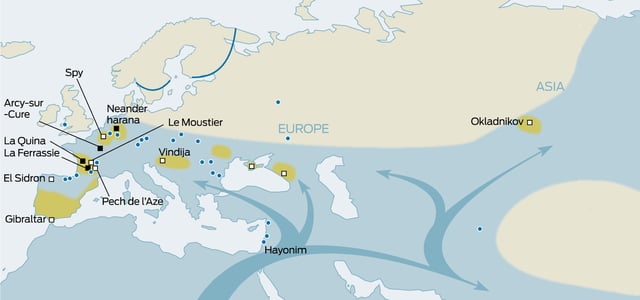
Replacement of Neanderthals by early modern humans.
The exact nature of biological and cultural interaction between Neanderthals and other human groups has been contested.[189] The dating of the period of overlap has been repeatedly revised. In 2011, this period of coexistence was extended when what were previously thought to be Neanderthal baby teeth, unearthed in 1964 from the Grotta del Cavallo in Italy, were identified as the oldest modern human remains discovered anywhere in Europe, dating from between 43,000 and 45,000 years ago.[195] At that time, Neanderthal samples from Iberia were thought to have dated as recently as 24,000 years ago, but a 2014 study of Neanderthal bones and tools led to a redating of these samples, and indicated that Neanderthals died out in Europe between 41,000 and 39,000 years ago, with the two different human populations sharing Europe only for about 5,000 years.[192] However, a 2019 reanalysis of skull fragments from southern Greece assumed to have belonged to Neanderthals concluded that they belonged to a modern human, and dated them to 210,000 years ago, vastly extending the period of potential overlap in Europe between the two groups.[196][197][198]
Neanderthals inhabited that continent long before the arrival of modern humans. These modern humans may have introduced a disease that contributed to the extinction of Neanderthals, and that may be added to other recent explanations for their extinction. When Neanderthal ancestors left Africa potentially as early as over 800,000 years ago they adapted to the pathogens in their European environment, unlike modern humans, who adapted to African pathogens. This transcontinental movement is known as the Out of Africa model. If contact between humans and Neanderthals occurred in Europe and Asia the first contact may have been devastating to the Neanderthal population, because they would have had little, if any, immunity to the African pathogens. More recent historical events in Eurasia and the Americas show a similar pattern, whereby the unintentional introduction of viral or bacterial pathogens to unprepared populations has led to mass mortality and local population extinction.[199] The most well-known example of this is the arrival of Christopher Columbus to the New World, which brought and introduced foreign diseases when he and his crew arrived to a native population who had no immunity.
Anthropologist Pat Shipman suggested that domestication of the dog could have played a role in Neanderthals' extinction.[200]
History of research

Krapina 3, female (1899)
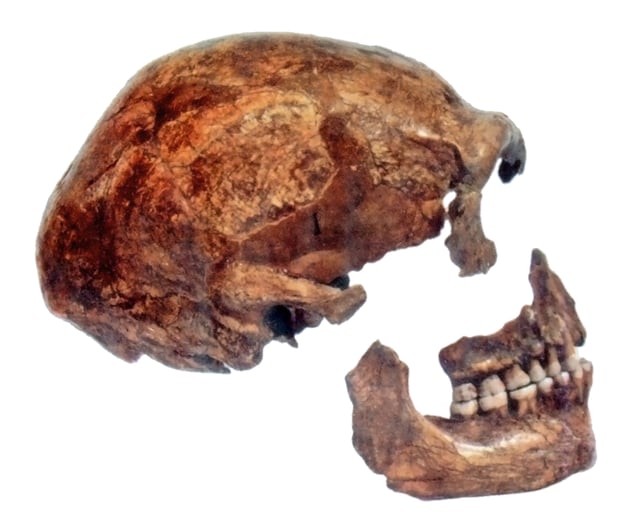
Spy 2 skull, sex unclear[201] (1886)
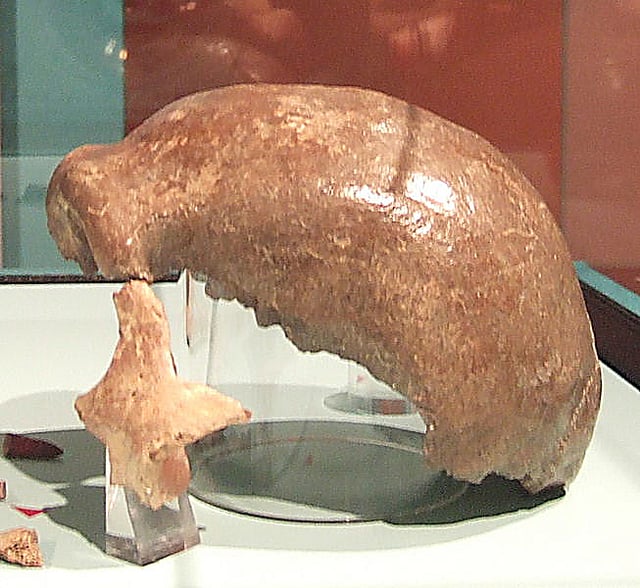
Neanderthal 1, male (upper skull 1856, left-cheek 2000)
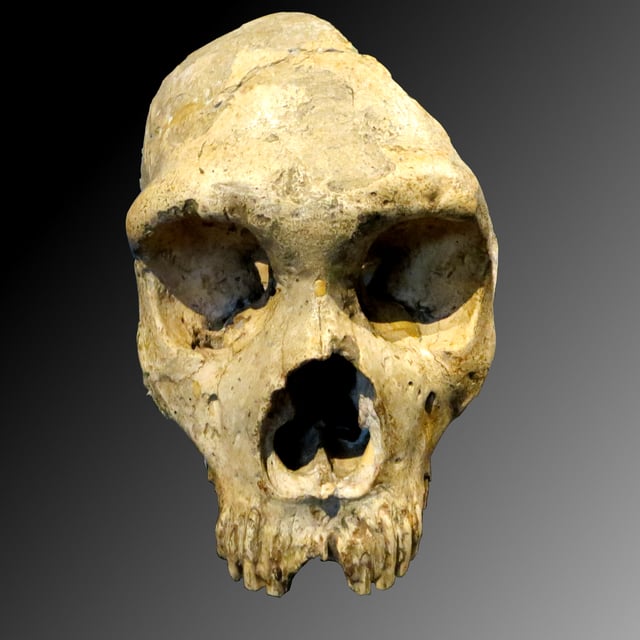
Gibraltar 1, female (1848)
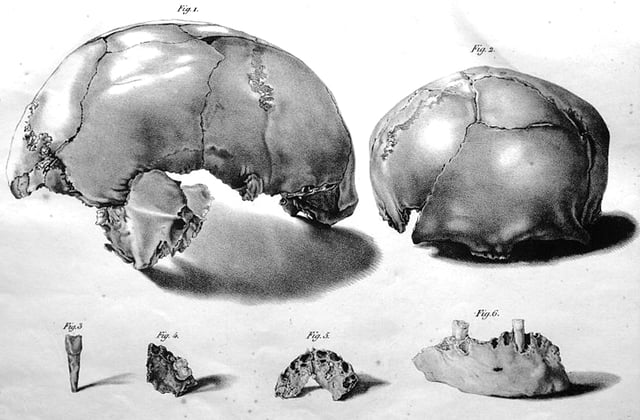
Engis 2, child (1829)
Neanderthal fossils were first discovered in 1829 in the Engis caves (the partial skull dubbed Engis 2), in present-day Belgium by Philippe-Charles Schmerling and the Gibraltar 1 skull in 1848 in the Forbes' Quarry, Gibraltar. These finds were not, at the time, recognized as representing an archaic form of humans.
The first discovery which was recognized as representing an archaic form of humans was made in August 1856, three years before Charles Darwin's On the Origin of Species was published. This was the discovery of the type specimen, Neanderthal 1, in a limestone quarry (Feldhofer Cave), located in Neandertal Valley in the German Rhineland, about 12 km (7 mi) east of Düsseldorf). The find consisted of a skull cap, two femora, three bones of the right arm, two of the left arm, parts of the left ilium, fragments of a scapula, and ribs. The workers who recovered the objects originally thought them to be the remains of a cave bear. However, they eventually gave the material to amateur naturalist Johann Carl Fuhlrott, who turned the fossils over to anatomist Hermann Schaaffhausen.[202]
To date, the bones of over 400 Neanderthals have been found.[203]
1829: A damaged skull of a Neanderthal child, Engis 2, is discovered in Engis, Netherlands (now Belgium).
1848: A female Neanderthal skull, Gibraltar 1, is found in Forbes' Quarry, Gibraltar, but its importance is not recognised.
1856: Limestone miners discover the Neanderthal-type specimen, Neanderthal 1, in Neandertal, western Prussia (now Germany).
1864: William King is the first to recognise Neanderthal 1 as belonging to a separate species, for which he gives the scientific name Homo neanderthalensis. He then changed his mind on placing it in the genus Homo, arguing that the upper skull was different enough to warrant a separate genus since, to him, it had likely been "incapable of moral and theistic conceptions."[36]
1880: The mandible of a Neanderthal child is discovered in a secure context in Šipka cave, in the Austro-Hungarian Empire (now the Czech Republic), associated with cultural debris, including hearths, Mousterian tools, and bones of extinct animals.
1886: Two well-preserved Neanderthal skeletons are found at Spy, Belgium, making the hypothesis that Neanderthal 1 was only a diseased modern human difficult to sustain.[204]
1899: Sand excavation workers find hundreds of fragmentary Neanderthal remains representing at least 12 and likely as much as 70 individuals on a hill in Krapina, in the Austro-Hungarian Empire (now Croatia).
1908: A very well preserved Neanderthal, La Chapelle-aux-Saints 1, is found in its eponymous site in France,[205] said by the excavators to be a burial, a claim still heatedly contested.[118][114][115] For historical reasons it remains the most famous Neanderthal skeleton.[63] []
1912: Marcellin Boule publishes his now discredited influential study of Neanderthal skeletal morphology based on La Chapelle-aux-Saints 1.
1953–1957: Ten Neanderthal skeletons are excavated in Shanidar Cave, Iraqi Kurdistan, by Ralph Solecki and colleagues.
1975: Erik Trinkaus's study of Neanderthal feet strongly argues that Neanderthals walked like modern humans.
1981: The site of Bontnewydd, Wales yielded an early Neanderthal tooth, the most north-western Neanderthal remain ever.
1987: Israeli Neanderthal Kebara 2 is dated (by TL and ESR) to 60,000 BP, thus later than the Israeli anatomically modern humans dated to 90,000 and 80,000 BP at Qafzeh and Skhul.
1997: Matthias Krings et al. are the first to amplify Neanderthal mitochondrial DNA (mtDNA) using a specimen from Feldhofer grotto in the Neander valley.[30]
2005: The Max Planck Institute for Evolutionary Anthropology and associated institutions launch the Neanderthal genome project to sequence the Neanderthal nuclear genome.[206]
2010: Discovery of Neanderthal admixture in the genome of modern populations.[23][163][164]
2014: A comprehensive dating of Neanderthal bones and tools from hundreds of sites in Europe dates the disappearance of Neanderthals to 41,000 and 39,000 years ago.[207]
2018: Report on the complete genomic sequence of Denisova 11, a first generation of Neanderthal-Denisovan hybrid.
2019: 257 hominin footprints were revealed by archaeologists at Le Rozel (Normandy, France). This finding, the vast majority of which consists of young footprints, has proved that Neanderthals lived in this area 80,000 years ago.[208][209]
Specimens
Notable European Neanderthals

Teshik-Tash 1

Kebara 2

Shanidar 1, skull cast

Le Moustier 1 in 2011

Le Moustier 1 in 1909

La Ferrassie 1, skull cast
Remains of more than 300 European Neanderthals have been found. For the most important, see List of human evolution fossils.
Neanderthal 1: The first human bones recognised as showing a non-modern anatomy. Discovered in 1856 in a limestone quarry at the Feldhofer grotto in Neanderthal, Western Prussia (now Germany), they consist of a skull cap, the two femora, the three right arm bones, two left arm bones, the ilium, and fragments of a scapula and ribs.
La Chapelle-aux-Saints 1: Called the Old Man, a fossilised skeleton discovered in La Chapelle-aux-Saints, France, by A. and J. Bouyssonie, and L. Bardon in 1908. Characteristics include a low vaulted cranium and large browridge typical of Neanderthals. Estimated to be about 60,000 years old, the specimen was severely arthritic and had lost all his teeth long before death, leading some to suggest he was cared for by others.
La Ferrassie 1: A fossilised skull discovered in La Ferrassie, France, by R. Capitan in 1909. It is estimated to be 70,000 years old. Its characteristics include a large occipital bun, low-vaulted cranium and heavily worn teeth.
Le Moustier 1: One of the rare nearly complete Neanderthal skeletons to be discovered, it was excavated by a German team in 1908, at Peyzac-le-Moustier, France. Sold to a Berlin museum, the post cranial skeleton was bombed and mostly destroyed in 1945, and parts of the mid face were lost sometime after then. The skull, estimated to be less than 45,000 years old, includes a large nasal cavity and a less developed brow ridge and occipital bun than seen in other Neanderthals. The Mousterian tool techno-complex is named after its discovery site.
Notable Southwest Asian Neanderthals
Remains of more than 70 Southwest Asian Neanderthals have been found. For a complete list see List of Southwest Asian Neanderthals.
Shanidar 1 to 10: Eight Neanderthals and two pre-Neanderthals (Shanidar 2 and 4) were discovered in the Zagros Mountains in Iraqi Kurdistan. One of the skeletons, Shanidar 4, was once thought to have been buried with flowers, a theory no longer accepted. To Paul B. Pettitt the "deliberate placement of flowers has now been convincingly eliminated", since "[a] recent examination of the microfauna from the strata into which the grave was cut suggests that the pollen was deposited by the burrowing rodent Meriones tersicus, which is common in the Shanidar microfauna and whose burrowing activity can be observed today".[210]
Amud 1: A male adult Neanderthal, dated to roughly 55,000 BP, and one of several found in a cave at Nahal Amud, Israel. At 178 cm (70 in), it is the tallest known Neanderthal. It also has the largest cranial capacity of all extinct hominins: 1,736 cm3.[62][211]
Kebara 2: A male adult post-cranial skeleton, dated to roughly 60,000 BP, that was discovered in 1983 in Kebara Cave, Israel. It has been studied extensively, for its hyoid, ribcage, and pelvis are much better preserved than in all other Neanderthal specimens.
Notable Central Asian Neanderthal
Teshik-Tash 1: An 8–11-year-old skeleton discovered in Uzbekistan by Okladnikov in 1938. This is the only fairly complete skeleton discovered to the east of Iraq. Okladnikov claimed it was a deliberate burial, but this is debated.
Chronology
This section describes bones with Neanderthal traits in chronological order.
Mixed with H. heidelbergensis traits
H. neanderthalensis fossils
130–50 ka: Krapina, Saccopastore skulls, Malarnaud, Altamura, Gánovce, Denisova, Okladnikov, Pech de l'Azé, Tabun 120–100±5 ka,[214] Shanidar 1 to 9 80–60 ka, La Ferrassie 1 70 ka, Kebara 60 ka, Régourdou, Mt. Circeo, Combe Grenal, Erd 50 ka, La Chapelle-aux Saints 1 60 ka, Amud I 53±8 ka,[215][216] Teshik-Tash.
In radiocarbon range, > 50 ka: Le Moustier, Feldhofer, La Quina, l'Hortus, Kulna, Šipka, Saint Césaire, Bacho Kiro, El Castillo, Bañolas, El Sidrón (48±3 cal ka),[217] Arcy-sur-Cure, Châtelperron, Figueira Brava, Mezmaiskaya (41±1 cal ka),[14] Zafarraya, Vindija, Velika Pećina.
H. s. sapiens with traits reminiscent of Neanderthals
< 35 Peștera cu Oase 37-42 ka, Mladeč 31 ka, Peștera Muierii 30 ka (n/s),[218] Lagar Velho 1 24.5 ka.
In popular culture
Neanderthals have been portrayed in popular culture including appearances in literature, visual media and comedy. Early 20th century artistic interpretations often presented Neanderthals as beastly creatures, emphasising hairiness and a rough, dark complexion.[219]
See also
Homo floresiensis – Extinct species of the genus Homo
Homo luzonensis – Extinct species of genus Homo
Denisovan – Paleolithic-era taxon of the genus Homo
Early human migrations
List of Neanderthal sites
Neanderthals in Gibraltar
